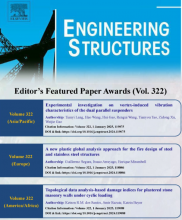Its authors: Guillermo Segura, Itsaso Arrayago and Enrique Mirambell are members of the Departament d'Enginyeria Civil i Ambiental de l'Escola Tècnica Superior d'Enginyeria de Camins, Canals i Ports de Barcelona.
The article presents a detailed numerical study on the design of carbon and stainless steel structures under fire conditions and proposes a new methodology to estimate the resistance of these structures in case of fire. This methodology takes into account the load redistribution capacity of these structures, significantly improving the accuracy of the fire resistance predictions of structures made from both materials, and leading to more efficient and safer designs.
The new generation of standards for the design of steel and stainless steel structures allows the use of advanced analysis-based designs that take advantage of the system capacity of whole structures at room temperature, provided that the structure's joints allow for it. However, when it comes to designing the same structures in the fire situation, standards still focus on the strength of individual members that comprise these structures, without considering how internal forces are redistributed due to the overall response of the structure, and ignoring the effects of the strain hardening of the materials.
The authors of the paper have demonstrated that both carbon steel and stainless steel structures are capable of redistributing forces even at elevated temperatures, provided that the cross-sections are stocky and the joints are sufficiently ductile. This finding has allowed the development of a new calculation approach, a novel method that considers global collapse mechanisms in fire situation adequately, and which ultimately allows taking into account the effects of the whole system, thus ensuring more efficient and safer designs.
Futher information: https://www.sciencedirect.com/science/article/pii/S0141029624014482?via%3Dihub


